Building the Living Seas
Image: Disney
By late 1979, the design of the pavilion was finally beginning to shift, and would only continue to do so throughout the early '80s. Chalk this pavilion's grand origins and spectacular style to Imagineer Tim Delaney. Despite he and his team's earnest efforts, engineers reported that Disney's hopes for a completely-underwater, glass-enclosed sea-base in the center of a 5 million gallon tank were simply not feasible.
The Living Seas was refined to be quite a bit closer to the final look and feel of the final pavilion, with a SeaBase built not in the center of the salt water tank, but in a two-story arrangement set on one side of the tank, with 5-8 inch thick acrylic windows as portals into the pool.
Image: Disney
The Omnimover attraction, too, was reduced to its smallest form yet. Now, the SeaCab attraction wouldn't feature any dark ride scenes. Instead, a 375 foot long ride path would simply glide through the central aquarium en route to SeaBase Alpha. The glass tubes planned for the ride's grand finale became acrylic windows looking out into the aquarium instead, and the "fantasy" elements of the attraction were slowly sapped so that the fanciful world of Poseidon gave way to a futuristic, scientific ocean research base.
By late 1980s, the Living Seas had more or less been designed. But it wouldn't open until four years after the rest of the park. Even in "reduced" form, the aquatic pavilion was one of the largest projects ever undertaken by the Walt Disney Company. Reportedly, the cost for the pavilion topped $90 million (equivalent to about $200 million today), made possible by sponsorship from United Technologies – an international engineering and aerospace firm.
Image: Disney, via Diz Avenue
Here at Theme Park Tourist, we offered an in-depth feature exploring the staggering statistics behind the Living Seas pavilion, but just imagine: Walt Disney World became the site of the sixth largest ocean on Earth. (And wonderfully, the Living Seas' central aquarium – the Caribbean Coral Reef Aquarium –remained the largest saltwater tank on Earth for 20 years, beaten only by the Georgia Aquarium in 2005.)
When the Living Seas opened on January 15, 1986 – more than four years after the rest of the park – still-new CEO Michael Eisner and Disney President Frank Wells were on hand for the underwater ribbon-cutting. Even back then, the AZA-accredited Living Seas was home to 4,000 creatures. What was a trip inside like? That's where we're headed next...
The Living Seas
Welcome to The Living Seas, presented by United Technologies.
Image: Derek Hatfield, Flickr (license)
Say what you will of Future World's gargantuan, imposing pavilions – each features a grand and iconic approach that makes guests feel right at home. Whether its the curving Omnimovers of World of Motion gliding around its central, mirrored support column; the leaping gardens and glass pyramids of Imagination; the towering greenhouse pinnacle of The Land; or this spectacular entry to The Living Seas.
Even if early designs for a rocky, water-carved exterior eventually transformed into the sculpted, smooth, paneled exterior we see, this more organic, curving, natural pavilion is made of layered pieces, undulating and curling like waves. And out front, an outcropping of sea-eroded rocks stands in the center of a pool. Waves crash across the simple scene, atomizing into a mist that suspends across the grotto.
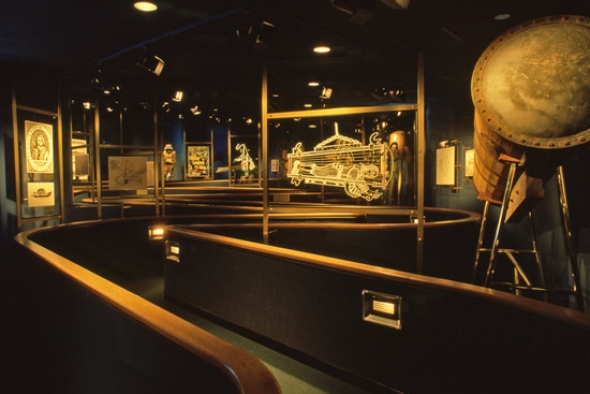
Image: Disney
Passing into the cool pavilion's dark interior, a winding queue passes through a hall with displays and models of seafaring ships, nautical instruments, and tools meant to bring mankind closer to understanding the sea. As in original plans – the pavilion's introduction is a theater with long blue benches. But our focus here is one familiar to many of EPCOT Center's early pavilions: an educational film that will begin our story a very, very long time ago. "Try to imagine, just for a moment, that somewhere in the endless reaches of the universe ... on the outer edge of a galaxy of a hundred thousand million suns ... deep within a cluster of slowly forming planets, a small sphere of just the right size lies just the right distance from its mother star ... cooling in the coldness of space. Try to imagine."
Image: Disney
What follows is an eight-minute film through the formation of Earth, the creation of oceans teeming with the first phytoplankton, creating oxygen, driving the planet's weather, and making our Blue Planet unlike any other we know: suited for life; the origins of oceanic exploration; ships... explorers... submersibles...
"Try to imagine, just for a moment, a future of amazing technological creativity ... a future of incredible adventure and discovery ... a future of remarkable awareness of understanding."
and now, a glass-enclosed research base deep on the ocean floor. "...Try to imagine. For we welcome you now to take the first steps into that future. We welcome you to The Living Seas. We welcome you to Sea Base Alpha."
Doors to the theater's side slide open, revealing a new antechamber beyond with illuminated, flashing signs offering: Hydrolators to SeaBase Now Boarding."
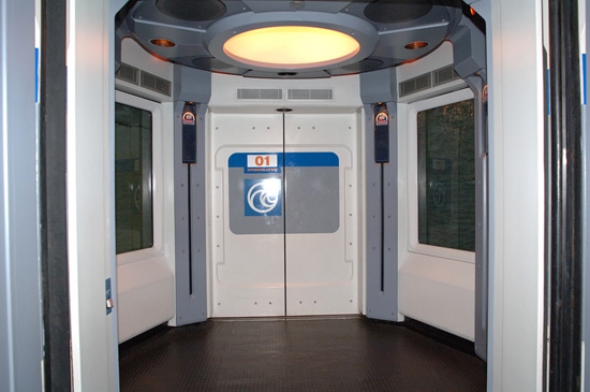
Image: Disney
The fabled Hydrolators of The Living Seas are remembered as an attraction unto themselves. Three Hydrolator pods are here, each accomodating up to 30 guests. As the rocky walls of a drilled shaft ascend and bubbles rise past in acrylic windows, you might be entirely convinced that you're descending deep into the ocean... (And indeed, a popular tale suggests that a guest attempted to sue Disney for ear damage from the mounting "pressure" – almost certainly nothing more than an urban legend.)
Of course, in actuality, the Hydrolators are that most spectacular of Disney feats: a deceptively simple special effect that's deeply convincing in context.
As the Hydrolators exit, guests are ushered to the next stage of the attraction. For, though we're deep underwater, we've not yet arrived at our final destination – the deep-ocean research site, SeaBase Alpha.
For that, we'll need to step aboard a SeaCab. This chain of constantly-moving ride vehicles resembles the same Omnimover ride system made famous in Disneyland's Lost Legend: Adventure Thru Inner Space and applied later to the Haunted Mansion, but these SeaCabs don't pivot. They face forward as they round the corner and enter a window-lined tunnel looking out into the Caribbean Coral Reef.
Real fish swim around, and if you're lucky, you may even see a SeaBase Alpha researcher out for a dive amongst the wildlife.
Image: Disney
The ride through the massive tank – ostensibly, the ocean from our point of view as guests – is short, but spectacular. And wonderfully, it's not even the highlight of the Living Seas! Now that we've traveled from our initial descent point through the water, we've arrived at SeaBase Alpha.
Image: Disney
SeaBase Alpha is a spectacular, futuristic deep submersible base, two stories tall and set against the endless vastness of the ocean we just traveled through. And this is where our adventure truly begins. After all, SeaBase Alpha is ours to explore. Visitors can then walk into a two-story central viewing area, completely surrounded by sea windows which allow them to see the divers live and up close carrying out research studies.
But there's so much more to this massive underwear research station.
Image: Disney
At the center of SeaBase Alpha stands the famous Diver Lock-out Chamber. Every half hour, divers enter or exit the Caribbean Coral Reef by way of this two-story tall tube, with SeaBase researchers on-hand to explain the latest in wetsuit and portable air tank technologies. Otherwise, SeaBase Alpha's two floors are explorable by way of "Modules" built off of the main gallery.
Level 1 of SeaBase Alpha includes a 24-foot long wave tank and four Module labs:
- Module 1A: Ocean Ecosystems, which included a 3,000 gallon Pacific Coral Lagoon aquarium with starfish, sea anemone, and hermit crabs as well as a Predator Tank with barracudas, moray eels, and connet head sharks, plus side-set aquariums dedicated to symbiosis, bioluminescence, and camouflage.
- Module 1B: Marine Mammal Research Center, which offered underwater viewing of the Living Seas' renowned collection of West Indian manatees.
- Module 1C: Earth Systems, which contained displays of ocean composition, tectonic plates, fault lines, and the "Animated Atlas of the World" looping video display.
Image: Disney
- Module 1D: Undersea Exploration, which featured an Audio-Animatronics display of Bob Ballard's JASON deep sea research rover and cutaway JIM suits for families to explore.
Climbing to Level 2 provides a glimpse of the second level of the Pacific Kelp Forest in Module 2A, and above-water viewing of the manatees in Module 2B.
Altogether, over 6,000 sea creatures live here, including rays, fish, sharks, manatees, and dolphins. Spend as much or as little time as you like exploring the Living Seas – an hour or a day. This pavilion isn't about a headlining ride. It's a collection of experiences encouraging deeper exploration, allowing access to real animal care and research, and seeing marine animals up close – animals that, otherwise, many humans would live their whole lives without seeing firsthand.
Image: Disney
When you're finished visiting, simply board another Hydrolator for your return trip to the surface! Naturally, The Living Seas was a spectacular demonstration of engineering, and of Disney's ability to transport guests to new worlds. By placing a world-class and record-breaking aquarium into an immersive world, this pavilion became another headliner at EPCOT Center.
But it wouldn't stay that way. As the years passed, a few nagging problems began to develop at EPCOT Center's foundation... Things were about to begin to change, and The Living Seas would become a test bed for a new way of doing things... Read on...
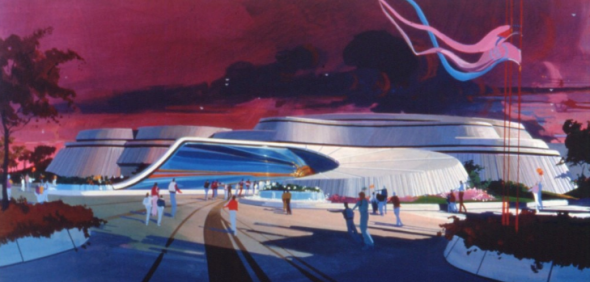
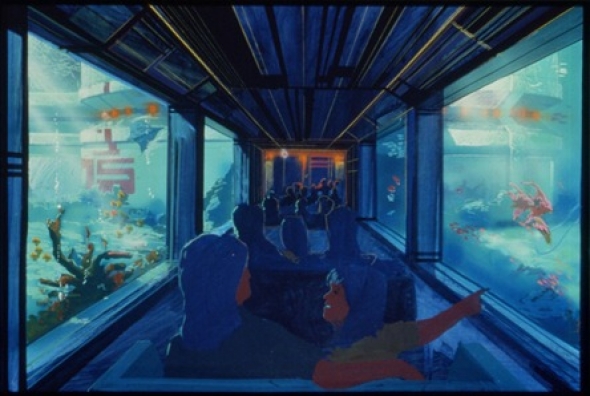
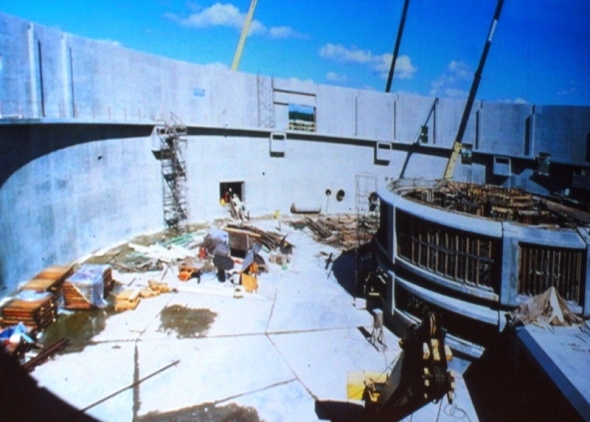
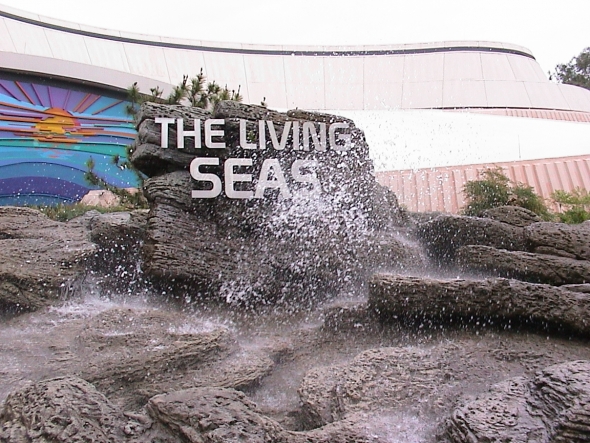
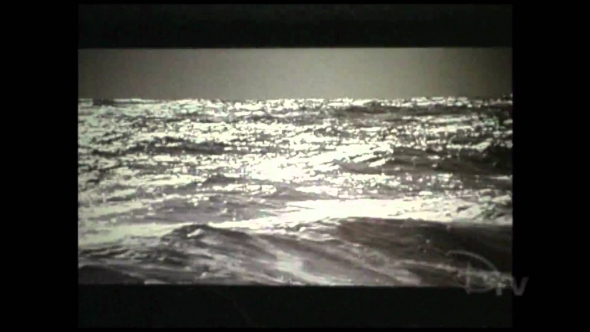
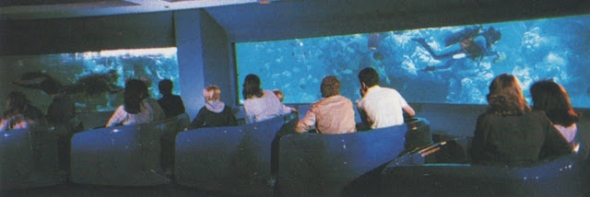
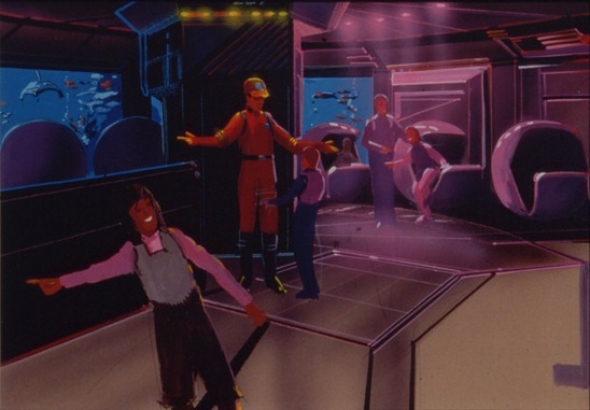
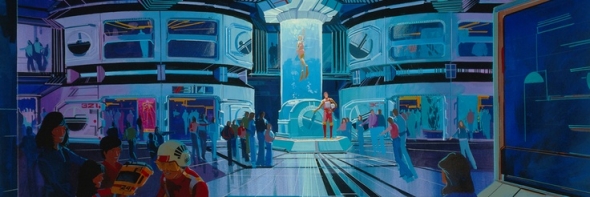
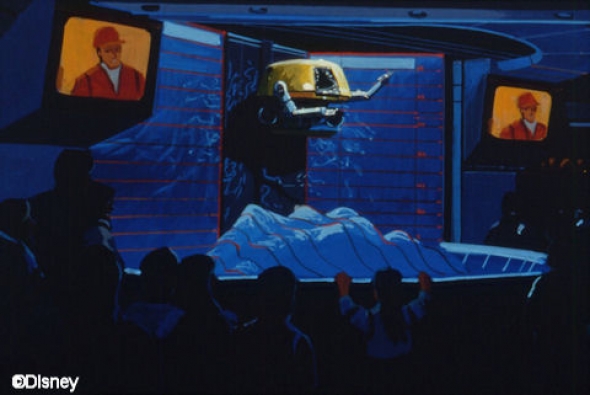
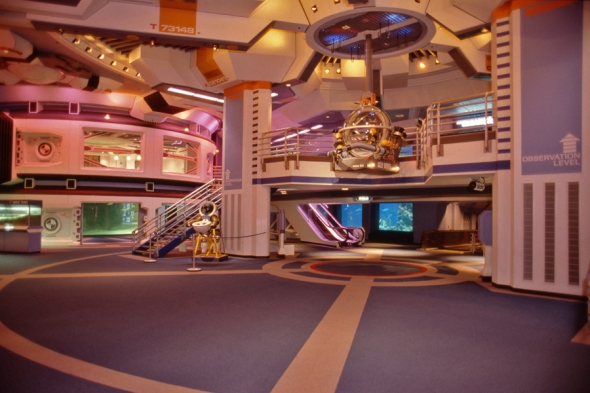

Add new comment